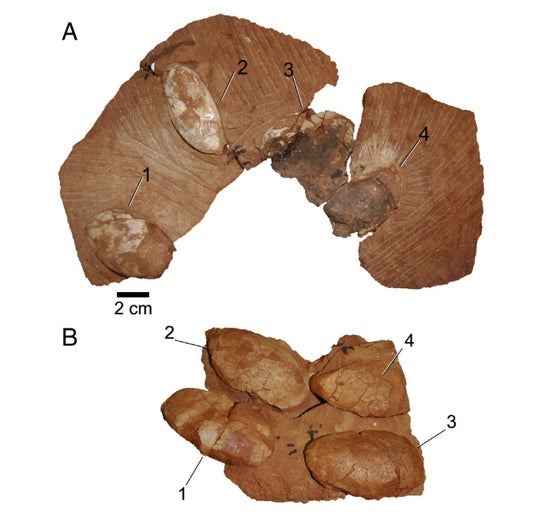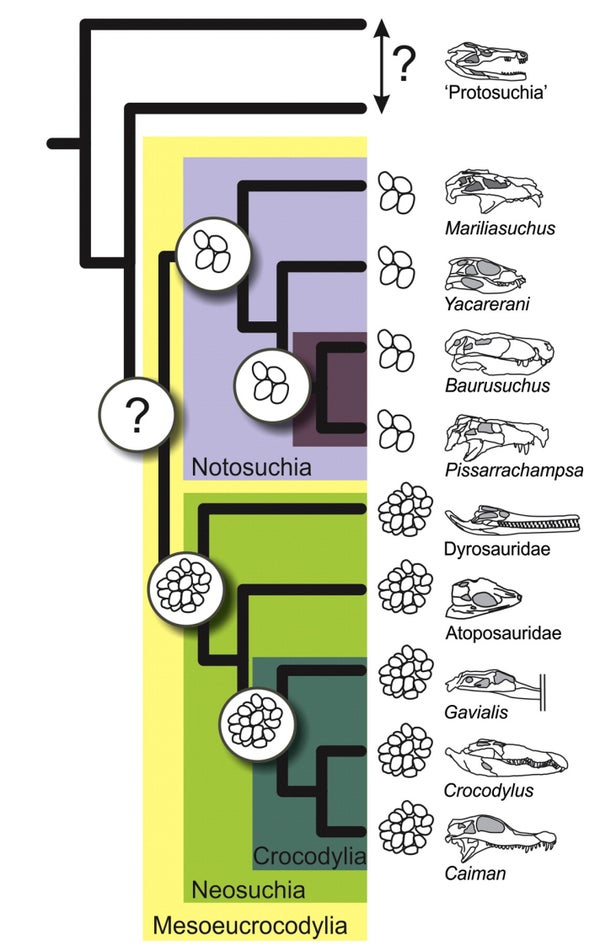This article was published in Scientific American’s former blog network and reflects the views of the author, not necessarily those of Scientific American
One day, around 72 million years ago, a mother crocodile scratched her claws into the sandy soil along the edge of an ephemeral lake. Not that she would have looked much like the crocodiles we know today if we had been able to see her. Later to be dubbed Pissarrachampsa by paleontologists, she held her body up on straight limbs, and her deep, snaggletoothed snout was more like what you'd expect from a predatory dinosaur than a crocodile. It's a look that speaks to her role in the Cretaceous world, not as an aquatic ambush predator but as a terrestrial stalker. In that long lost moment in time, though, she wasn't digging to hunt. She was moving the sandy soil to lay a clutch of four eggs that would survive the slow tick of time to come down to us as fossils.
This mother Pissarrachampsa wasn't alone. In the same spot, paleontologist Júlio de A. Marsola and colleagues report in a study published earlier this year, multiple eggs and egg clutches have been found in the same geologic layer that produced the bones of Pissarrachampsa itself. For gravid mother crocs, this was the place.

Eggs attributed to Pissarrachampsa. Credit: de A. Marsola et al. 2016
On supporting science journalism
If you're enjoying this article, consider supporting our award-winning journalism by subscribing. By purchasing a subscription you are helping to ensure the future of impactful stories about the discoveries and ideas shaping our world today.
Finding eggs at all is a big break. The fragile embryo containers do not fossilize as often as the sturdy bones of the adult animals that laid them. But finding eggs likely laid by Pissarrachampsa adds a new wrinkle to the main event of crocodile life through the ages - reproduction.
In the big picture of crocodile evolution, Pissarrachampsa is what experts called a crocodyliform, and more specifically a notosuchian. This is a completely extinct group of ancient crocodiles, many of which were dramatically different from our modern alligators, gharials, and their kin (belonging to a different branch called neosuchians). And while bones made it apparent that notosuchians lived very different lives from their more aquatic cousins, the eggs add more evidence that notosuchians reproduced in a different way, too.

Clutch size in crocs. Credit: de A. Marsola et al. 2016
Modern alligators, crocodiles, and gharials lay large clutches of eggs, and their close prehistoric relatives appear to have done the same. But notosuchians, like Pissarrachampsa, only laid small clutches of eggs. Each at the site in Brazil contained only four, and occasionally five, eggs to a clutch. (Compare that to up to 80 laid by Nile crocodiles!) This, de A. Marsola and coauthors write, might mean that Pissarrachampsa was what biologists would deem a k-selected species - a species where parents leave a small number of offspring, but invest more energy or care so that those few have a greater chance of making it to adulthood and leaving descendants of their own.
Whether or not small clutch size represents the ancestral state for crocodiles is a mystery, but de A. Marsola and colleagues hope that future finds of even older, more archaic croc nests will help bring resolution to how these ruling reptiles changed strategies through the ages. There is a sadness to such finds. The embryos inside the fossil eggs never got to hatch or grow up. But such sorrow is only because we know the end of the story. Turn the fossil another way and it's not a symbol of death, but remnant of life, a piece of a few moments when a mother Pissarachampsa nestled her eggs into the soil as a hope for the future.
Reference:
Marsola, J., Batezelli, A., Montefeltro, F., Grellet-Tinner, G., Langer, M. 2016. Palaeoenvironmental characterization of a crocodilian nesting site from the Late Cretaceous of Brazil and the evolution of crocodyliform nesting strategies. Palaeogeography, Palaeoclimatology, Palaeoecology. doi: 10.1016/j.palaeo.2016.06.020